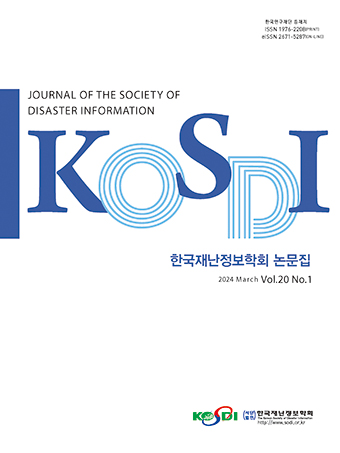Original Article
Abstract
References
Information
Purpose: This study aims to draw the problems and improvements of NFSC 103 sprinkler head discharge obstruction prevention standard to increase the fire extinguishing performance of sprinkler system in order to contribute to the protection of people's lives and property in the event of a fire. Method: NFSC 103 was compared to NFPA 13 which is the latest 2019 version in U.S in terms of sprinkler head discharge obstruction prevention. Results: This study found that NFSC 103 doesn’t define even the basic concept of sprinkler discharge obstruction. And NFSC 103 doesn’t have detailed standard for side wall sprinkler head discharge obstruction prevention as well as the “height” criteria of the “three times” separation rule. Conclusion: NFSC 103 needs a lot of supplements and improvements such as the addition of definition for water discharge obstructions, the adoption of sidewall sprinkler heads standard for preventing water discharge obstructions and the additional establishment of the “three times rule” considering the “height” of obstacles to promote the advance of fire safety standard equal or above fire fighting advanced country and increase the reliability for the suppression performance of sprinkler system.
연구목적: 본 연구는 스프링클러설비 소화성능 향상을 위해 국내 NFSC 103 스프링클러헤드 살수장애 방지 기준의 문제점을 검토하고 이의 개선방안을 도출함으로서 화재 시 국민의 생명과 재산 보호에 기여하는 것을 목적으로 한다. 연구방법: 국내 NFSC 103 스프링클러헤드 살수장애 방지 기준의 문제점과 이의 개선방안을 도출하고자 소방선진국인 미국 화재방호협회(NFPA) 최신 스프링클러 설치기준인 2019년판 NFPA 13 의 스프링클러헤드 살수장애 방지 기준을 국내 화재안전기준 NFSC 103과 비교 연구하였다. 연구결과: 국내 NFSC 103 살수장애 방지 기준은 살수장애 개념조차도 정의되어 있지 않고 있을 뿐만 아니라 측벽형 스프링클러 헤드 살수장애 기준 부재, “3배 이격” 기준의 “높이” 기준 부재 등 다수의 상세기준에서 많은 보완 및 개선이 필요함이 연구결과 확인되었다. 결론: 국내 NFSC 103 살수장애 방지 기준은 살수장애의 개념적 정의 도입, 측벽형 스프링클러 헤드 살수장애 방지기준 추가, 장애구조물 사용실태를 고려한 헤드 추가기준 마련, 장애물 “높이”를 고려한 “3배 이격” 거리 기준 보완, 살수패턴을 반영한 살수장애 방지기준 상세화 등 의 개선을 통하여 소방선진국과 동등 수준 이상으로의 화재안전기준 선진화를 도모하고 이를 통하여 스프링클러 설비의 소화성능에 대한 신뢰성을 증진시켜 나가야 한다.
- Ahrens, M. (2017). U.S Experience with Sprinkler, National Fire Protection Association, U.S, pp. 2-6 .
- Chatterjee, P., Geiman, J.A. (2017). Numerical Simulations of Sprinkler Activations and Spray Transport Under Obstructed, Sloped Ceilings, FM Global, U.S.
- Floyd, J., Budnick, E., Boosinger, M., Dinaburg, J., Boehmer. H. (2010), Analysis of the Performance of Residential Sprinkler Systems with Sloped or Sloped and Beamed Ceilings, The Fire Protection Research Foundation, U.S.
- Great American Insurance Group (2006). Loss Control Data Guide-Sprinkler Head Discharge Obstructions and Impediments, ISO Services Inc., U.S, p.1.
- Hague, D.R., Duffy, C.W. (2019). Automatic Sprinkler Systems Handbook 14th Edition, National Fire Protection Association, U.S , p.73.
- NFPA 13 (2019). Standard for the Installation of Sprinkler System, National Fire Protection Association, U.S.
- NFSC 103 (2017). Automatic Sprinkler Systems Fire Safety Code, National Fire Agency.
- Palenske, G.A., Geiman, W.A. (2014). Obstruction and ESFR Sprinklers-Phase 1, National Fire Protection Association, U.S.
- Publisher :The Korean Society of Disaster Information
- Publisher(Ko) :한국재난정보학회
- Journal Title :Journal of the Society of Disaster Information
- Journal Title(Ko) :한국재난정보학회논문집
- Volume : 16
- No :2
- Pages :237-247
- DOI :https://doi.org/10.15683/kosdi.2020.06.30.237




 Journal of the Society of Disaster Information
Journal of the Society of Disaster Information







